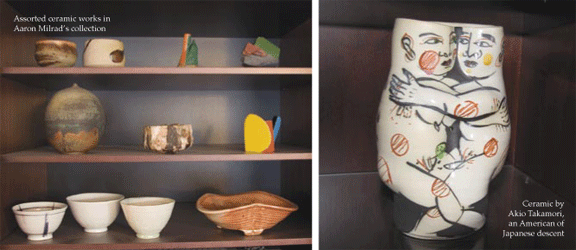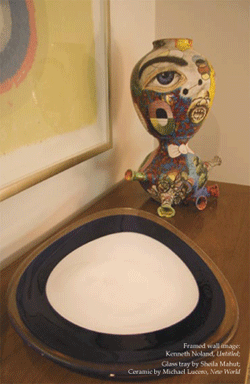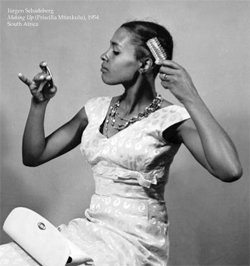ONLY COLLECT
You
don’t have to be a billionaire
to amass works of art. Here’s
how to go about it
By
Moira Daly
TORONTO
ART COLLECTOR Aaron
Milrad still thinks about the one
that got away. It was 1960 and Milrad,
then a third-year law student, faced
the classic collector’s dilemma:
should he spend $250 he had scraped
together on the second half of his
law-school tuition or on a Harold
Town canvas he had discovered at a
gallery on Bloor Street?
In the end, Milrad’s
sensible lawyer’s head won out
over his art-loving heart and he returned
the painting to the gallery.
“That picture would have been
about $25,000 today,” Milrad
says, “but besides that, it
was a beautiful work.”
Esthetic enjoyments,
the thrill of the hunt or the chance
for a big windfall are some of the
reasons why those who like art begin
collecting. For many, what begins
in a small way with one or two canvases
or a few treasured objects, soon blossoms
into a lifelong obsession.
 |
|
Photographs
of Aaron Milrad's collection
by Yuri Dojc |
Consider Kenneth
Thomson, aka Lord Thomson of Fleet,
Canada’s most prominent art
collector. Thomson is a communications
mogul and the world’s 15th richest
man, according to Forbes magazine.
His collection, which includes works
by Turner, Constable and Rubens, is
valued at more than $300 million.
But when five palm-sized ivory carvings
he had loaned to the Art Gallery of
Ontario were stolen and later returned
last year, Thomson’s delight
confirmed that collecting is often
passion over reason. On the day of
their return, Thomson said he planned
to sleep with the carvings that night.
“I usually
have three dogs on my bed,”
Thomson said at a news conference.
“[Tonight] I’m going to
have one dog and five ivories on my
bed.” The carvings, valued at
$1.5 million, were among the first
artworks he acquired, Thomson explained,
so they had enormous sentimental value.
You need not be an
eccentric press baron, a dot-com billionaire
or a distant Medici heir to begin
collecting, experts say. Even those
of comparatively modest means can
amass an interesting, enjoyable and
potentially lucrative collection,
as long as they are willing to put
in the work.
For many, the first
step may be overcoming their trepidation
about entering the art world, with
its occasionally impenetrable artspeak
and overabundance of people in unusual
glasses. That insecurity is the natural
result of a widespread lack of familiarity,
says Louise Beaudry, an art consultant
in Montreal.
“From a very
young age we should be brought into
contact with art, so we have an opportunity
to develop a critical eye. Otherwise,
it is only when we are older and have
a big wallet that we start to think
about it.”
Beaudry’s
firm, Propos d’Art, groupe conseil
Inc., helps businesses build collections
to fit their corporate images. For
a company that works with young professionals,
for example, Beaudry created a collection
of dynamic, contemporary works to
represent the irresistible pull of
the future.
Individuals often
set off on a particular path for more
personal reasons. “Collecting
came into my life as a way to explore
an identity and a culture,”
says Kenneth Montague, a Toronto dentist.
Montague’s photography collection,
which focuses on black culture in
different places and eras, has its
roots in his upbringing in Windsor,
Ont., in the 1970s. Visits to museums
in Detroit with his open-minded parents
exposed him to images of and by African-Americans.
“They looked impossibly sophisticated
and I thought, ‘Someday I will
get out of Windsor and that will be
me.’”
Milrad’s mother
collected British ceramics and his
father was a Sunday painter. His collection,
which currently hovers around 400
pieces, includes post-Second World
War ceramics, sculpture and paintings
by abstract artists Jack Bush and
Helen Frankenthaler.
Abstract art made since the Second
World War is also the focus of theatre
impresario David Mirvish’s renowned
collection, although he is not sure
he would define himself as a collector.
“I am someone
who likes to see certain ideas expressed
and exhibitions take place and I lend
pictures to institutions that have
something that they want to say about
the artist that interests me,”
he says.
Each of us has our
own way of looking and our own way
of responding, says Mirvish, and that
will determine what we collect—or
if collecting is even appropriate.
When it comes to contemporary art,
such as conceptual art or land art,
collecting may not be an option, Mirvish
points out. “The artist Robert
Irwin, for example, has devoted the
last 20 years to making art that you
can’t collect. He did the renovation
and grounds of the Dia Center and
the gardens at L.A.’s Getty
Museum, both of which are extraordinary,
but not collectible in the conventional
sense.”
 |
| |
For the most part,
however, the art market is broad enough
to respond to almost any interest,
Mirvish adds. “You can still
collect 17th-century Dutch painting,
if you want. There is a Jacob van
Ruisdael exhibition right now at the
L.A. County Museum and a number of
those painting are privately owned
and still there in the marketplace.
And they’re not any more expensive
than some contemporary artists who
are fashionable at this moment who
made pictures last year.”
Familiarity is often
the key, says Miriam Shiell, a Toronto
art dealer. “Canadians will
obviously have a comfort level in
buying the art of their own history.
That’s not unique to Canadians.
Every country has a national art that
people collect and they compete over
it fiercely to get what they want.”
The ferocity of
that competition often drives people
into the arms of dealers and consultants.
Aspiring collectors should do as much
of their own homework as they can
by reading widely, visiting shows
and nosing around in the backrooms
of galleries. Seeking out knowledgeable
advice is a good idea, experts agree,
both as a way to train the eye and
to negotiate a market that has international
reach.
Stephen Bulger,
a Toronto photographer dealer, Maia
Sutnik, head of collections at the
AGO and curator Robert Osbourne have
all been instrumental in the creation
of his collection, Montague says,
and have encouraged his curatorial
activities under the name Wedge. “Stephen
said he didn’t find any problem
or fault with a dentist opening a
gallery. He was so positive and supportive.”
Dealers can tell you about the history
of an artist, their movement and keep
you updated, says Milrad. Beyond that,
courting dealers can increase your
chances of gaining access to the work
you covet, says Shiell. “You
build a good relationship with these
people and when they get something
decent, they’ll phone you up.”
Auction houses are
another source of information and
often the only place to purchase very
high profile works. “The auction
is the great leveler because that’s
where all the retailers buy,”
says Valerie Brown, head of the Ontario
central division for Waddington’s,
a Toronto-based auction house. “Personally,
I’m always very happy when I
am bidding against a dealer, because
if I get the next bid, I know I’ve
saved a lot of money.”
Regardless of where
you buy, buy what you love and buy
the best that you can afford, the
experts say. “You can’t
predict if a painting is going to
go up or down,” says Mirvish,
“but the intrinsic value is
the quality of the vision and the
object. If those are there, the financial
side seems to take care of itself.”
 |
|
Photographs
by Jürgen Schadeberg
courtesy of Kenneth Montague |
Collecting art is
also one of the few private endeavours
with enormous potential to give back,
collectors agree. For Mirvish, that
means participating in the conversation
about art in numerous ways. Milrad
is continually donating works from
his collection to institutions large
and small. Montague, meanwhile, has
been spending less time doing root
canal and more time acting as an exhibition
sponsor. Wedge also runs programs
for children who can’t access
art by traditional means. “You’ve
got to put your money where your mouth
is,” Montague says. “Sharing
is what this is about.”
Even when you think
you’ve got it all under control,
remember that one of the great joys
of collecting is the surprises it
brings, Mirvish says. After viewing
the haunting paintings of Vilhelm
Hammershoi, a Danish artist, at a
1983 exhibition in London, Mirvish
spotted a Hammershoi hanging in a
gallery window. He and his wife were
in a cab on the way to the airport.
Mirvish asked the driver to stop and
wait, and half an hour later, he came
out with his Hammershoi—one
of only two he knows about in Canada.
“My picture is from about 1909,”
he says, still amazed. “I don’t
collect 1909 art.”
It is, indeed, about
the journey and not the destination,
says Catriona Jeffries, a Vancouver
gallery owner. “Do you buy five
or 10 works, slap your hands together
and say, ‘That’s that’?
Or do you allow yourself to go on
a cultural exploration that will last
a lifetime?”
The rewards of connoisseurship
will come over time, says Beaudry.
“It is like tasting wine. At
first you might try something very
cheap, but somewhere along the line,
someone will offer you something much,
much better.” 
FORGERY:
NOT A PRETTY PICTURE
As criminals go,
forgers have had an easy ride. Often
seen as gentlemanly scamps or misunderstood
folk heroes, tales of their exploits
are celebrated as frequently as they
are condemned.
Certainly, the good
fakers can be as inventive and free-spirited
as any “real” artist.
“You wake up in the morning
and you just feel like today is a
Picasso day, today is a Monet day,”
convicted forger John Myatt once said.
Myatt used K-Y jelly to add body to
his brush strokes. In 2003, after
spending just four months in jail
in 1999, he put his authentic fakes
up for sale in a British gallery.
Prices ranged up to $10,000 US.
Bake your canvas
at 80 C for a day if you want it to
crack from top to bottom, advises
famous British faker Leo Stevenson,
who describes his work as “inventions
in the style of Old Masters.”
Worried that your phoney, gilded artifact
looks too shiny and new? No problem,
said flamboyant Italian forger Icilio
Federico Joni in his 1936 autobiography,
Affairs of a Painter. Try soaking
the stump of a Tuscan cigar in water
for a day to make a useful glaze.
While modern science
has spawned many sophisticated techniques
to uncover fakes, there is still no
foolproof filter, experts say. More
than half the objects brought into
the Royal Ontario Museum by the public
are fakes, estimates Dan Rahimi, executive
director of gallery development, while
the rate is about one in 100 for objects
in the museum’s collection or
that it acquires.
Even experienced
collectors can have the wool pulled
over their eyes. Just ask Taylor Thomson,
only daughter of businessman Kenneth
Thomson, a prominent collector of
Canadian art. Taylor Thomson purchased
a pair of gilded urns, allegedly made
in 1760, for £1.9 million ($4
million) at Christie’s in London
in 1994, beating out U.S. oil heiress
Ann Getty. Experts later told her
they were inferior 19th-century imitations.
Thomson sued the auction house and
the cash-strapped British nobleman
who had put the urns up for sale,
and in May 2004, a British judge ruled
in her favour.
More fakers and forgers
will feel the long arm of the law
if the U.S. Federal Bureau of Investigation
has anything to say about it. This
past March, the agency introduced
a special squad of eight art-savvy
agents. Art fraud does not a pretty
picture make, said FBI spokesman Bill
Carter. “It’s an ugly
criminal specialty and we’re
seeing more of it all the time.”
| Four
Ways to Foil Fraud Artists |
1.
Acquire as much knowledge
as you can in the field you
wish to collect. Study museum
collections, follow auction
sales and read, read, read!
Visit dealers, join societies
of collectors and attend conferences
and symposiums. Introduce yourself
to experts in the field. Never
buy anything unless you know
what it is.
2.
Be wary of
artifacts made in China and
Africa. Entire factories in
China are devoted to the production
of fake antiquities and they’re
difficult to spot with the naked
eye. Up to 90 per cent of African
artifacts are fakes, experts
say.
3.
Provenance—where
an object comes from and who
owned it—is as equally
important as authenticity. An
object is only worth as much
as its paper trail. Keep sales
receipts, auction catalogues
and anything that provides a
record of where, when and how
something has been acquired.
4.
Be wary of
objects that might have been
exported illegally from a war
zone. Mesopotamia (read Iraq),
Afghanistan, Iran and Egypt
are places to watch out for. |
| Source:
Dan Rahimi, executive director
of gallery development at the
Royal Ontario Museum, and Corey
Keeble, curator of world cultures
at the ROM. |
|